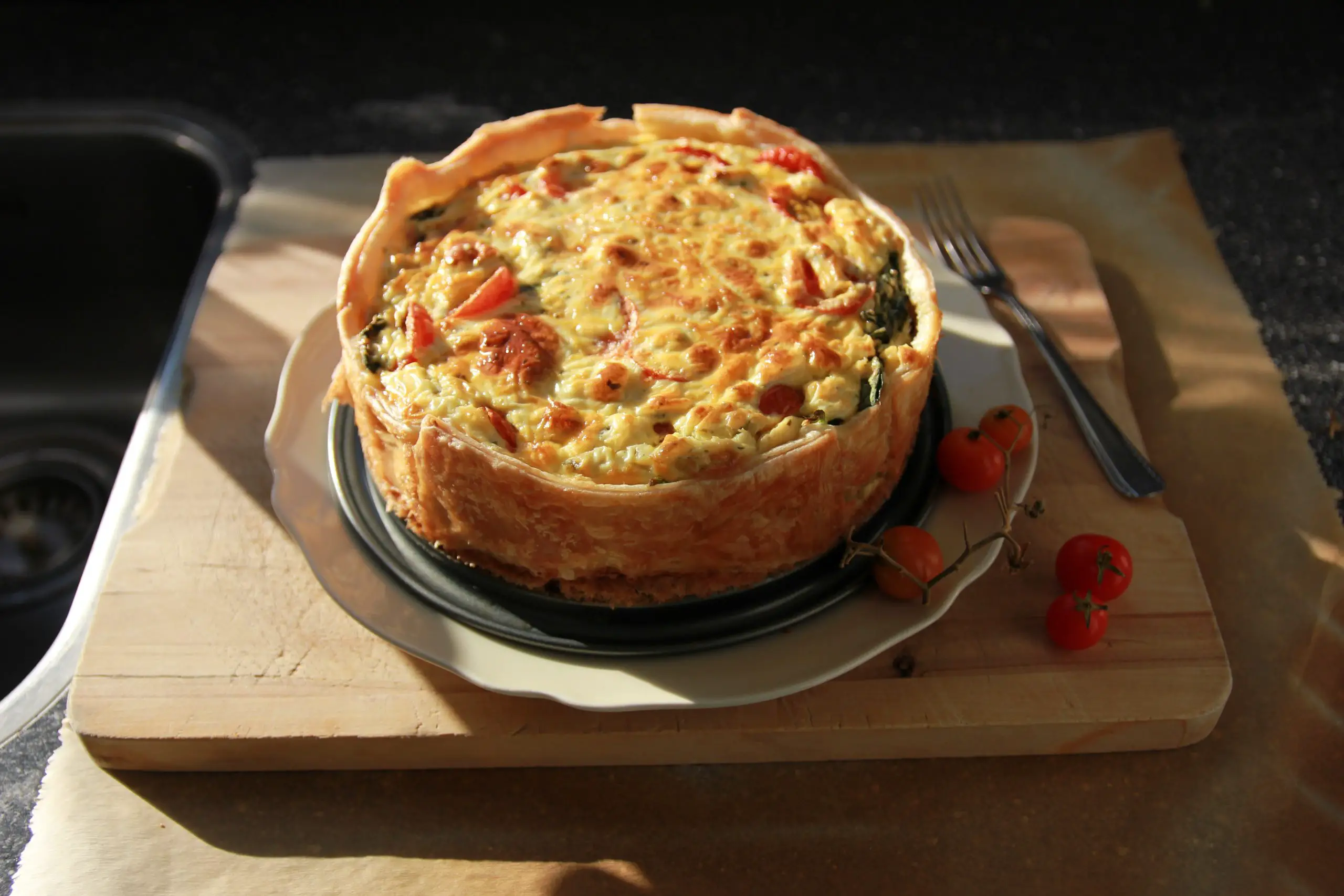Keeping your quiche fresh can be a challenge. You can ensure your quiche retains its flavor for as long as possible. Here we’ll show you how to freeze quiche, we’ll also discuss safe methods for defrosting and cooking previously frozen food, and you’ll find out how long a quiche keeps. So, if you have some leftovers or want to cook something quickly for the week ahead but are curious if they can be frozen, this article is for you. Stay with us until the end because you will learn much about quiche here.

How to Freeze Quiche?
Quiche can be frozen most effectively just before baking. If you can freeze the filling and crust separately, let’s say you can freeze leftover quiche, and if you prefer, you can freeze freshly prepared uncut and unbaked fritters. As remarkable as it may sound, this is the perfect way to get results that taste just as good as if they were freshly prepared.
Reduced air exposure, which prevents freezer burn and adversely affects flavor and texture, is the most important aspect of any freezer food packaging. Quiche (or any dish with eggs) freezes best if it is prepared, tightly packed, and frozen before baking. You can enclose it in various layers of plastic coat and a layer of foil (or a tight-fitting lid). For up to three months, please put it in the freezer.
Freezing the Quiche Filling and Crust Separately
The crust and filling should be frozen separately if you want the crust to be crispier and flakier after being frozen and thawed. It makes sense to do this since it keeps the filling from making the crust soggy.
Creating the filling: Making the quiche’s filling is the first step. Your eggs and any other ingredients the recipe specifies will be included.
Add to a plastic bag by pouring the following:
- Wait to heat the filling once it has been prepared.
- Leave space towards the top as you pour the filling into a freezer-safe plastic bag.
- Before sealing the freezer bag, take out as much air as possible.
- Label the freezer bag with the contents’ name and the freezing date.
Get the Pastry Ready: Although preparing and rolling out the crust a few days before baking the quiche is advised, you can do so in advance and freeze it if you need long-term preservation. The pastry should be rolled out and put into a suitable pan.
Put in a Freezer Bag: Once the crust has been rolled out and placed in the pie pan as desired, place the pie pan and the pastry inside a sealed bag and squeeze out as much air and water as feasible. The content’s name and the freezing date should be written on the plastic freezer bag before it is sealed.
Freeze: When you’re ready to assemble and cook the quiche, place the plastic freezer bags with the filling and the crust in the freezer and ensure they stay at a reliable temperature of 0 degrees Fahrenheit. This method of freezing a raw quiche allows for storage for three months in the freezer.
The crust and filling should be left in the refrigerator to thaw until you’re ready to use them, with the filling taking longer than the crust. After adding the contents to the crust, bake the dish as directed. Simple! Just remember that the likelihood of the crust being crisp and flaky decreases as you freeze it for a longer period.
Freezing the Quiche Filling and Quiche Crust Together
The unbaked crust and filling can be frozen together if you don’t want to freeze them separately. This helps you conserve freezer space and completely thaw the quiche when it’s time to eat it. Keep in mind that if frozen with the filling, the crust won’t be particularly flaky or crispy.
Put the Quiche Together: Follow the recipe’s instructions to prepare the filling and the crust. Without baking the crust, add the filling within.
Get Ready for Freezing: Place the quiche on a baking sheet once the filling and crust have been prepared. If any filling leaks, line the baking sheet with parchment paper to make cleanup easier.
Up Until Firm, Freeze: Place the quiche-containing baking sheet in the freezer and leave it flat. It will take several hours for the quiche to freeze and become hard. To avoid the filling sticking to the plastic wrap, you will be used to wrap it and make sure it has frozen solid.
Wrapping up: Remove the quiche from the freezer once it has frozen solidly, and then wrap it up tightly in plastic wrap. To make an airtight seal, press the plastic wrap’s edges down. After enclosing it in plastic wrap, you can cover the quiche with aluminum foil. The plastic wrap prevents the aluminum foil from clinging to the quiche when frozen, protecting it from freezer burn.
If neither plastic wrap nor aluminum foil is available, put the entire quiche in a sizable freezer bag. Before securing the bag tightly, take out as much air as possible, and label it. Without significantly losing quality, constructed quiche can be placed in the freezer for up to a month.
You may bake the quiche straight from the freezer when it’s time to dine. Just remember to bake it for an extra 10 to 20 minutes to allow for defrosting. You can avoid thawing the quiche overnight in the refrigerator by doing this. After this, it will still be safe to consume, but the quality won’t be the best.
Additional Guidelines for Freezing Quiche
- Cooked quiches can be warmed up from the freezer; you need to allow for extra cooking time to account for the quiche’s defrosting process. Let the cooked quiche cool fully before freezing it. This enables you to wrap the quiche in plastic wrap without worrying about condensation, which could result in ice crystals and a drop in quality.
- It also stops the warm quiche from heating the freezer, which could endanger the other frozen foods. If you prefer the quiche to be better protected, you can freeze it in a tin.
- You can cut cooked quiches into individual slices and freeze them if you want to consume only part of the pie. The quiche may be cut into slices, which you can then arrange on a baking pan. Please put this in the freezer and wait for it to freeze completely.
- Once completely frozen, cover each slice in aluminum foil and then plastic wrap before putting it into a large freezer bag. This way, you may detach one slice at a time to thaw without having to defrost an entire quiche and have half of it go to waste.
- You can also create tiny quiches and freeze them as you would bake on a smaller scale. Both kids and parties would like these.
- If your quiche has a lot of vegetables, it might get watery when reheated. To avoid the veggies becoming overly mushy, it is preferable to freeze the filling uncooked for this.
How Long does Quiche Stay Fresh?
Quiche can only be kept in the fridge for 3 to 4 days. Please do not open it or leave it outside during this time. It should always be kept sufficiently cool to avoid losing its flavor and quality. Quiche has a shelf life of two to three months in the freezer. If you plan to freeze it unbaked, set a reminder to bake the quiche before the one-month mark.
Why is my Frozen Quiche Soggy?
Reheating quiche occasionally results in a runny quiche or soggy crust because of the high egg content. Bacon may get mushy in the microwave if the quiche incorporates it, such as Lorraine.
Can you Eat a Cold Quiche?
Quiche is safe to eat cold. However, it is not advised. Instead of being soft and buttery like when it is fresh, cold quiche will be rubbery and spongy. But as long as it has been properly preserved and fresh, quiche can be consumed cold without causing health problems.
How to Safely Defrost Quiche?
Quiche can be safely defrosted using patience. Many impatient people will speed up the defrosting of leftovers in their microwave by using the defrost setting. On the other hand, we strongly advise you to refrigerate the quiche for 24 hours before eating it.
The fantastic news is that most of the techniques discussed above can be used to bake quiches straight from the freezer without having to wait to defrost for a considerable time. The one exception is when you want to eat uncooked quiches that are divided and frozen separately. This will guarantee that it is secure for consumption, maintains its shape, and stays sweet and crisp.
If the crust and filling for the quiche were frozen separately, you should thaw them for 24 hours before adding the defrosted filling to the crust and baking. To ensure that a crustless quiche, which is essentially just quiche filling, bakes more evenly and firmly, it should also be properly defrosted before baking.
How can you Reheat Frozen Quiche?
Whether to reheat leftovers in the oven or the microwave is a constant debate. But when it comes to quiche, the oven is always a winner. We all want our dinner as fast as possible; therefore, even though you might be tempted to use the microwave, this is the one time you should resist the urge to use it instead of waiting patiently.
A quiche should always be reheated in the oven. Remember that your quiche contains plenty of eggs and occasionally cream. These two ingredients must be thoroughly warmed up before use because of their propensity to curdle.
Whether it has a crust or not, quiche is notorious for deflating. Your quiche will become a mushy mix of soft crust, cheese, and egg if you microwave it. If you properly reheat it in the oven by our directions, you will have a much firmer and crispier quiche that will taste just as amazing as the day you initially made it.
Conclusion
This article discusses whether quiche can be frozen. Many people enjoy eating quiche for lunch; you can fill it with whatever you like because it’s adaptable. Many believe it can’t be frozen because of the recipe’s heavy reliance on eggs.
The perfect source on freezing quiche, along with some extremely useful advice on warming, thawing, and the various methods you can use to freeze your quiche masterpieces. We sincerely hope you found this post helpful and that you can now toss away leftover quiche without fear.
